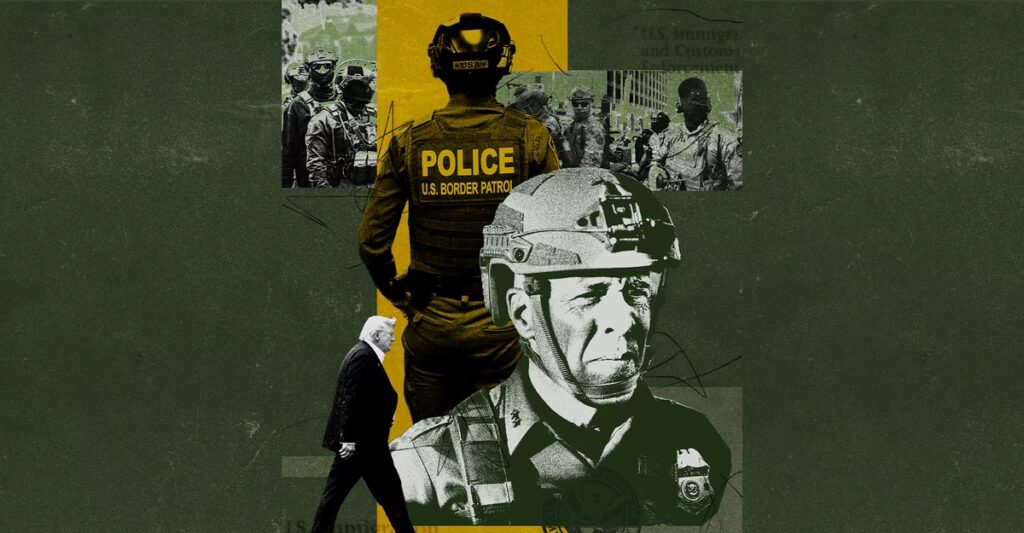The Border Patrol commander Gregory Bovino posted a video over the weekend showing a pep talk he’d given in Chicago to agents operating far from their usual stations along the Mexico border. Set to a rock anthem by the band Chicago, it was the kind of swaggering, trollish clip that has made him the star of the Trump administration’s mass-deportation campaign.
“This is our fucking country,” Bovino told the agents, gathered around him in a parking lot. “Nobody tells us where to go, when to go, how to go in our fucking country.” That same weekend, they hit the streets of Charlotte, North Carolina, raiding Home Depot parking lots and notching 130 arrests. Bovino called the operation “Charlotte’s Web,” quoting the classic children’s book to say his agents “take to the breeze, we go as we please.”
When President Donald Trump ran for office in 2024, his campaign wanted voters to tie the problems in their communities and personal lives to the chaos at the U.S.-Mexico border. Trump’s surrogates adopted a talking point long used by Homeland Security officials when they wanted more attention and funding from Congress. “Every state is a border state,” they’d say, meaning that problems generated at the border—illegal migration and drug trafficking—don’t stay there.
It should come as little surprise, then, that Trump and Stephen Miller, who oversees the administration’s mass-deportation campaign, have turned the U.S. Border Patrol inward, deploying its green-uniformed agents to cities and states around the country. During the Biden administration, when the number of illegal crossings soared to an all-time high—roughly 2 million a year—the Border Patrol was so overwhelmed that it turned to other federal agencies, including Immigration and Customs Enforcement, for help. Today those roles are reversed. Trump’s militarized border crackdown and ban on asylum seekers have reduced illegal crossings to the lowest levels since the 1960s, leaving Border Patrol agents with more time on their hands. ICE, which is responsible for enforcing immigration laws in U.S. cities and communities, is the agency that is now overwhelmed—by pressure from the White House.
Miller and Kristi Noem, the Department of Homeland Security secretary, told ICE officers in May that they wanted 3,000 immigration arrests a day, a nearly tenfold increase from the daily average last year. Trump had promised “millions” of deportations in his inauguration speech, and Miller and Noem threatened to sack ICE officials who failed to deliver. Arrests increased for a time, but the numbers declined to about 1,000 a day during the summer months. Displeased, Miller and Noem have started replacing the leaders of ICE regional offices with Border Patrol commanders.
[Read: As money rushed in, ICE’s rapid expansion stalled out]
Tom Homan, the former ICE acting director whom Trump designated as “border czar,” is no longer the face of the crackdown. That role now belongs to Bovino, the Border Patrol commander who has been taking what he calls his “Green Machine” on a traveling road show: first to Los Angeles, then Chicago, and now North Carolina, his home state. Trump has turned Bovino’s agents into a personal army as well as a political tool, picking which cities he wants them to strike based on shifting factors, including whether mayors are nice to him. (San Francisco’s leaders talked Trump out of a deployment last month.) Two ICE officials I spoke with expect the White House to send Bovino to New York City early next year after Mayor-Elect Zohran Mamdani is sworn in.
No president has ever used the Border Patrol this way. But the agency is modeling the kind of aggressive tactics Trump wants, raising the likelihood that the next phase of his crackdown will be more confrontational and violent. A federal judge this month found that Bovino and his agents used excessive force against protesters and the public in Chicago, while lying about the threats they faced. The judge put restrictions on their ability to use tear gas and force. The Trump administration appealed, and won a stay on Wednesday, but Bovino had already left town.
When asked by 60 Minutes if agents in Chicago had gone too far, Trump responded: “I think they haven’t gone far enough.”
Trump has often mused about sending active-duty troops to U.S. cities, but that risks running afoul of the Posse Comitatus Act, the 1878 law limiting the U.S. military’s role in domestic law enforcement. The president’s attempts to deploy National Guard troops have met legal resistance, too, and recent mobilizations in Chicago and Portland, Oregon, were blocked by federal courts that found the administration’s justifications thin.
Most of those troops have been withdrawn, but the Border Patrol is still ramping up. With their body armor, camouflage, and heavy weapons, agents look more like U.S. Marines than federal police officers. And they have broad latitude to enforce U.S. immigration laws.
Bovino, who travels with his own film crew, has been churning out the social-media clips and Fox News footage the White House craves. His agents are not the only Border Patrol forces the administration has deployed. Michael Banks, the top Border Patrol official, said during an interview with NewsNation Saturday that 2,000 agents, about 10 percent of the agency’s workforce, have deployed to 25 cities.
ICE and the Border Patrol are both part of DHS. The spokesperson Tricia McLaughlin wrote to me in a statement that the department “is one team, and we have one fight, to secure the homeland.” But the traditional division of labor between the two agencies has resulted in sharply different internal cultures. Because ICE has to operate in U.S. cities and communities, many of them run by Democrats, its officers have learned to conduct themselves with a relative degree of restraint and caution in order to accomplish their mission.
In the face of pressure from Democrats and activists’ calls for ICE’s elimination, the agency has worked to justify and defend its role in immigration enforcement. ICE officials have long insisted that they do not conduct indiscriminate sweeps or roundups. Their officers are trained to make “targeted” arrests that require them to formulate plans in advance, and to figure out how to take suspects into custody with minimal disturbance or risk. Determining the immigration status of the people they target is often complex and legally nuanced, and they go to great lengths to avoid the arrest of U.S. citizens, usually treating it as a screwup.
These methods help reduce community blowback and potential liability. But they aren’t conducive to racking up the deportation numbers the White House wants. Border Patrol agents, in contrast, often work in remote mountain and desert areas where anyone who shows up is a possible suspect. They face almost no downside to stopping someone to check their immigration status. Agents are trained to act first and ask questions later, because the biggest mistake they can make is allowing a dangerous person or a drug smuggler to get past them.
Scott Shuchart, an attorney and a former ICE official who worked at the agency’s Office of Civil Rights and Civil Liberties from 2010 to 2018, told me that ICE officers operate “more like a police force that does things with plans and considers collateral damage,” whereas the Border Patrol thinks of itself as a “defensive military agency” for which “nothing out there really matters except officer protection and the mission.”
“When there’s nothing else you could hit except, like, armadillos, of course you do less operational planning, and care less about collateral damage, than when you’re 15 feet away from a kindergarten,” he told me. “That is rationality and basic human decency, and not wanting to get sued and lose your house for running over a kid.”
During the Biden administration, DHS officials tried to remake ICE’s public image and defuse some of the anger generated by family separations in Trump’s first term. ICE officers were told to once more prioritize quality over quantity, and to target violent offenders, public-safety threats, and recent border-crossers, rather than focusing on sheer arrest numbers. Biden officials gave ICE’s Homeland Security Investigations division a lead role fighting the fentanyl crisis and Mexican traffickers. The “Abolish ICE” calls faded.
Trump has jettisoned that framework, along with directives urging ICE officers to avoid what the agency considers “sensitive locations” such as schools, hospitals, and churches. When reporters asked how the agency could possibly remove 1 million people a year—it had never deported half that many—Homan insisted that it would continue to conduct targeted enforcement and prioritize criminals. Nearly a year later, Trump officials still claim they’re going after “the worst of the worst,” long after that has become manifestly untrue.
The latest ICE statistics show that about one-quarter of those held in custody and facing deportation have criminal convictions. Only 16 of the 614 people detained in Chicago whose names were released in litigation over DHS’s “Operation Midway Blitz” were labeled public-safety threats by ICE, with convictions or pending charges such as driving under the influence and assault, court documents show.
“They just want numbers,” one administration official, who wasn’t authorized to speak with reporters, told me. A longtime ICE official told me Bovino is “out of control,” and warned that his expanding role will lead to the detention of more U.S. citizens and “more hate and more violence.”
[Read: The hype man of Trump’s mass deportations]
“If I walk up to somebody that’s minding their own business and just putting groceries in their car because we’re at a Latino supermarket,” the official said, “I’d be pissed too.”
“That’s going to fan the flames,” the official told me. “The more we get away from targeted enforcement operations with reasonable suspicion, the more you’re going to see what’s happening right now, with attacks on ICE. You’re going to lose the support of the American people.”
A common view among some of the most gung-ho Trump officials I’ve spoken with is that ICE was too passive and slow to act at the beginning of the administration. One senior DHS official told me that ICE’s Enforcement and Removal Operations division—responsible for immigration detention and deportations—has been “digging out” from years of underperformance. The officials described meetings where ICE’s Homeland Security Investigations agents would show up with suits, tablets, and PowerPoint reports, while shabbily dressed deportation officials would be “slouched around the table.”
“When you’d squeeze them for results, accuracy, and analysis, they would throw their hands up and say ‘Nobody likes us,’ or ‘We don’t have the systems to do that,’ or ‘That’s never been done before,’” said the official, speaking on condition of anonymity to describe internal tensions. “In the early days of this administration, that was exactly the frustration.”
The pressure to meet quotas has left many ICE officers burned out and on edge, according to veteran officials I’ve spoken with over the past several months. Some have visibly lost control, such as the ICE officer who was filmed tackling a distraught mother outside a New York City courtroom in September, or the officer who angrily handcuffed Chicago Alderperson Jessie Fuentes at a hospital last month when she asked ICE to show a warrant.
[Read: The conquest of Chicago]
At the meeting in May, Miller berated ICE officials who spoke up in defense of targeted enforcement, and ordered them to boost arrests by raiding Home Depot parking lots and other public places where they were likely to find immigrants they can deport. That was exactly what Bovino and his agents did when they arrived in Los Angeles soon after.
Bovino reports directly to Noem and Corey Lewandowski, the Trump-world insider who does not have a formal role at DHS but operates as the department’s de facto chief of staff. Bovino is the only Border Patrol commander whose social-media profile photo shows him holding a weapon. He represents a subculture within the agency that has tried to boost recruitment by making the job look more like military service, when in reality agents often spend long shifts sitting alone in their vehicles watching the border. His traveling strike force features Border Patrol tactical teams trained to jump out of helicopters, engage in combat against heavily armed traffickers, and put down riots and angry crowds.
In late September, Bovino’s teams flew a Blackhawk helicopter over Chicago’s South Shore neighborhood in the middle of the night so agents could rappel onto a roof and raid an apartment building they said had been taken over by Venezuelan gang members. Agents kicked down doors, set off stun grenades, arrested 37 people, and zip-tied others, including U.S. citizens. Six weeks later, DHS has not presented evidence of weapons or narcotics seized in the raid, and federal prosecutors have not filed charges against any of the people Bovino’s teams arrested, according to ProPublica.
A proposal to fold ICE into U.S. Customs and Border Protection, which includes the Border Patrol, has long been favored by immigration hard-liners aligned with Miller. The Heritage Foundation’s Project 2025 policy handbook urged the breakup of DHS and the creation of a stand-alone Cabinet-level department focused solely on border security and immigration enforcement.
Founded in 1924, the Border Patrol is known within DHS for its insular, paramilitary culture and success at capturing congressional funding. Within 100 miles of the U.S. border, its agents have the authority to operate roadside checkpoints and question the immigration status of passing motorists. Outside those areas, agents are allowed to question someone if they can articulate factors that add up to a reasonable suspicion that the person lacks legal status. This is a lower threshold than probable cause.
Soon after they arrived in Los Angeles, Bovino’s teams were sued for racially profiling Hispanic residents. A district court ordered Bovino to stop, but the Trump administration appealed to the Supreme Court, which sided with the government. Justice Brett Kavanaugh’s concurrence affirmed the ability of U.S. agents to use factors including ethnic appearance and speaking Spanish to develop a reasonable suspicion of illegal presence. The Trump administration viewed the ruling as a major victory, and a green light for Bovino to double down.
DHS insists that Bovino and the Border Patrol also conduct targeted enforcement. But when he and his agents arrived in Chicago this summer, they leaned even more into selecting locations considered “target-rich environments,” such as car washes and retail parking lots, where they can run searches on license plates and question pedestrians.
“Border Patrol’s operations are targeted. We do our research beforehand,” McLaughlin, the DHS spokesperson, wrote to me, listing serious crimes committed by suspects recently taken into custody by the administration. “Is it your contention we stop targeting these rapists, pedophiles, drug dealers, and career criminals?”
Kerry Doyle, an immigration attorney who led ICE’s legal department during the Biden administration, said Kavanaugh’s opinion affirmed the government’s broad authority to conduct checks, but she cautioned against viewing Bovino’s tactics as a significant departure from standard practice.
“I think that even before this, they probably relied quite heavily on people’s appearances and race and other similar characteristics,” Doyle told me. Immigration court is not like criminal court, where evidence gathered improperly can be suppressed, she noted. Being subjected to an immigration arrest by dubious methods does not bestow legal status on someone facing deportation. “The truth is that even if someone is stopped by ICE or CBP for what looks like an unconstitutional reason, there’s very little consequence for having done so,” Doyle told me.
Administration officials have described the Border Patrol mobilization as a temporary fix for an ICE staffing shortage. They say ICE remains on track to hire and deploy 10,000 new deportation officers by early next year, a surge that will more than double the size of its workforce. Their training schedule has been fast-tracked, but the process has been plagued by high dropout rates among recruits who have struggled to pass fitness tests and meet other standards.
Peter Mina, a former ICE attorney and deputy director of the agency’s Civil Rights and Civil Liberties Office, told me that “mission creep” between ICE and CBP is occurring at a time when new officers “aren’t going to get the training they need to do their jobs properly, with a clear delineation of what their missions are.”
“It’s just: Let’s get bodies out there,” Mina said.
DHS says it has received more than 200,000 applications for the ICE jobs, which offer a $50,000 signing bonus and other perks. Most of the new hires will be experienced law-enforcement officers from other federal agencies or state and local police departments, according to the department.
[Read: Who wants to work for ICE? They do. ]
Shuchart told me that would be a good thing, because ICE would benefit from having more veteran police officers who know how to navigate urban environments. “If they’re actually getting experienced cops who know what they’re doing, they might be better trained for this part of the mission,” Shuchart said. “It’s not obvious to me that getting a 15-year veteran of the Cincinnati Police Department would be a minus here.”
DHS has not said whether it’ll send Bovino and his agents back to their border jobs once the new ICE officers are ready.
*Lead illustration sources: Scott Olson / Getty; Anna Moneymaker / Getty; Kamil Krzaczynski / AFP / Getty; Ryan Murphy / Getty; Jamie Kelter Davis / Getty.
The post The Green Machine appeared first on The Atlantic.




